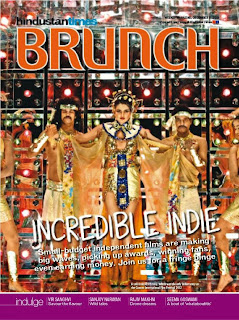[Archivio] Vi segnalo l'articolo The brave new world of indie films, di Parul Khanna, pubblicato da Brunch l'8 dicembre 2013:
'Indie films demystified (...)
The generic definition of an indie film points to a small-budget project made and distributed by an independent source, without the intrusion of a big studio. But in India, distribution is a big hurdle, and most times, it happens only with the help of established studios. So our indie films are often made with money from independent sources or a producer who chips in. (...) An indie film could also be made by collecting money from multiple sources. (...) Unlike the parallel cinema movement of the ’70s and ’80s, which focused on social injustices and everyday struggles, today’s indie films are not bound by any one theme. (...) Song and dance routines are optional. (...)
Stories with passion
The reasons driving India’s new-age indie filmmakers are varied. (...) Most indie filmmakers cite world cinema and satellite television as influences and with changing technology, they also have a better means of telling their story than before. A film can now be shot on a digital motion picture camera. (...) Software for editing and music is easily available. (...)
The roadblocks
If indie storytelling and filmmaking is original, then so are the ways to make and sell it. Big stars will fill theatres but cost money and compromise creativity. Even B-listers are often inaccessible. (...) Often, in the indie world, the star is not a person but a script. (...) Others cut location costs, edit everything on paper and plan better, so the project is more efficient. (...)
Changing tastes
Small films don’t always mean small successes. (...) This change in the way movies are being consumed is forcing filmmakers and production houses to change their thinking. (...) For big studios and stars, fringe films are also a means to invest in new audiences of the future. (...)
Release obstacles
While the nature of the stories has changed with indie cinema, other aspects are still fraught with old challenges. Once a movie is made, it just lies waiting for some Prince Charming distributor to pick it up. For films to be distributed and earn money, they still need to have stars. One reason distributors offer for not helping indie films is that they still aren’t drawing enough people to theatres. However, filmmakers complain that often films lose audiences because they aren’t advertised enough. But with promotion costs often running into four times an indie film’s budget, they’re understandably hard to promote too. (...) Several European countries (and the USA as well) make films direct to DVD or TV, solving the problem of distributors and cinema audiences India does. Add to it the threat of piracy, and it’s anyone’s guess how much money such a film will make. All of which means studio backing is an indie filmmaker’s only hope. Most indie filmmakers say the problem with the Indian distributor is that he acts as the spokesperson for what the audience wants. The distributor filters films even before the audience gets a chance to see them. (...)
Eyes on the world
All our indie films benefit from doing the festival circuit before they come to India. (...) [Anupama] Chopra, a regular at Cannes for years, says that there is a palpable change in our perception on the world stage. "For years, we had an Indian presence just on the red carpet. (...) This year, at Cannes, there were five movies officially selected." (...) The scene is evolving in India, too. (...) With an eye on a growing need for filmmakers to be trained like those in the Sundance Screenwriters Lab, the National Film Development Corporation of India has launched a lab of its own. (...) Still, non-mainstream cinema needn’t and shouldn’t be a byword for boring. That would be the death of the genre. No movie or filmmaker, by default, becomes good, just because it is indie'.
